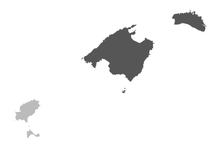Gymnesian Islands

The collective name of the Gymnesians (Catalan: Gimnèsies [ʒimˈnɛziəs], Spanish: Gimnesias) [ximˈne̞siäs], or Gymnesic Islands (Catalan: Illes Gimnèsiques),[1] distinguishes the two largest (and easternmost) Balearic islands (Majorca and Minorca), from the Pityuses (Catalan: Pitiüses; Spanish: Pitiusas), or Pine Islands (Ibiza and Formentera).
Etymology
The word Gymnesian (from the Greek γυμνήτες gymnetes) means "naked". The Ancient Greeks recruited the local inhabitants of these islands, the Talaiotics, as slingers. According to some researchers, this does not mean that they fought naked, but that they used much lighter armament than the hoplites.
Name usage
Later the Phoenicians referred to both Majorca and Minorca as the Baliarides. After the whole archipelago (the Pityuses and Gymnesians) came under Roman rule, the islands gained the overall Latin name Insulae Baliares or Baleares Insulae; and the collective concept has continued in use in modern languages, hence ultimately the English name "Balearic Islands".
In recent years the Catalan terms Illes Gimnèsies and Illes Pitiüses have come back to use in academic and scientific circles, because of the use of Greek-language sources for neologisms.
References
- Strabo Geography Book III, Chapter 2
- Belenguer, E. Història de les illes Balears. Barcelona: Edicions 62, 2004. 525 p. ISBN 84-297-5506-3 (volume I)
Coordinates: 39°48′46″N 3°34′34″E / 39.81276°N 3.57605°E